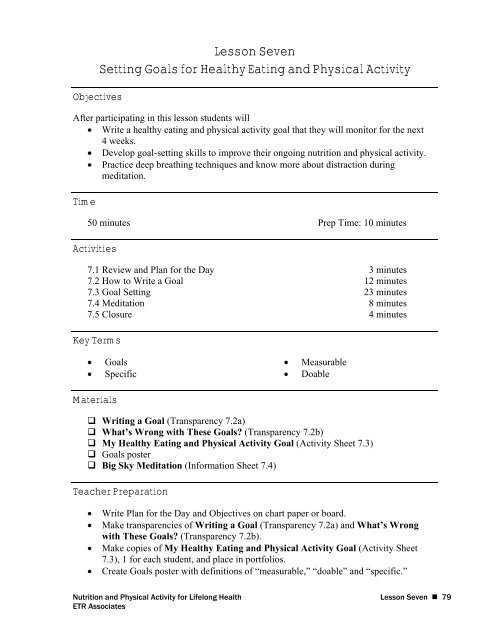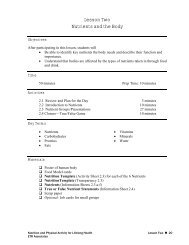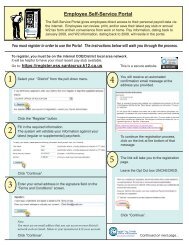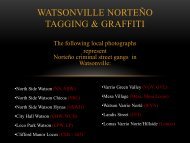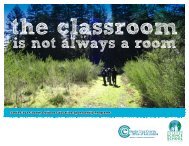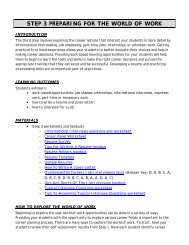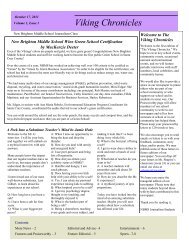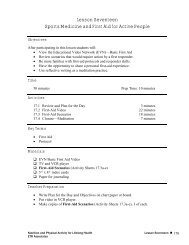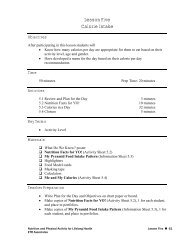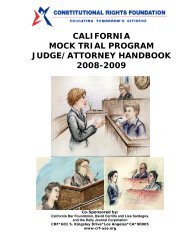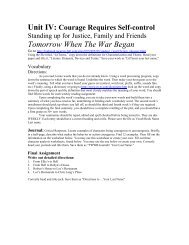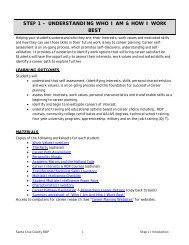Lesson 7 - Physical Education for Body, Mind and Spirit
Lesson 7 - Physical Education for Body, Mind and Spirit
Lesson 7 - Physical Education for Body, Mind and Spirit
- No tags were found...
You also want an ePaper? Increase the reach of your titles
YUMPU automatically turns print PDFs into web optimized ePapers that Google loves.
<strong>Lesson</strong> SevenSetting Goals <strong>for</strong> Healthy Eating <strong>and</strong> <strong>Physical</strong> ActivityObjectivesAfter participating in this lesson students will• Write a healthy eating <strong>and</strong> physical activity goal that they will monitor <strong>for</strong> the next4 weeks.• Develop goal-setting skills to improve their ongoing nutrition <strong>and</strong> physical activity.• Practice deep breathing techniques <strong>and</strong> know more about distraction duringmeditation.Time50 minutes Prep Time: 10 minutesActivities7.1 Review <strong>and</strong> Plan <strong>for</strong> the Day 3 minutes7.2 How to Write a Goal 12 minutes7.3 Goal Setting 23 minutes7.4 Meditation 8 minutes7.5 Closure 4 minutesKey Terms• Goals• Specific• Measurable• DoableMaterials Writing a Goal (Transparency 7.2a) What’s Wrong with These Goals? (Transparency 7.2b) My Healthy Eating <strong>and</strong> <strong>Physical</strong> Activity Goal (Activity Sheet 7.3) Goals poster Big Sky Meditation (In<strong>for</strong>mation Sheet 7.4)Teacher Preparation• Write Plan <strong>for</strong> the Day <strong>and</strong> Objectives on chart paper or board.• Make transparencies of Writing a Goal (Transparency 7.2a) <strong>and</strong> What’s Wrongwith These Goals? (Transparency 7.2b).• Make copies of My Healthy Eating <strong>and</strong> <strong>Physical</strong> Activity Goal (Activity Sheet7.3), 1 <strong>for</strong> each student, <strong>and</strong> place in portfolios.• Create Goals poster with definitions of “measurable,” “doable” <strong>and</strong> “specific.”Nutrition <strong>and</strong> <strong>Physical</strong> Activity <strong>for</strong> Lifelong Health <strong>Lesson</strong> Seven • 79ETR Associates
7.1 Review <strong>and</strong> Plan <strong>for</strong> the Day 3 minutesMaterials: Plan <strong>for</strong> the Day <strong>and</strong> ObjectivesWrite the Plan <strong>for</strong> the Day <strong>and</strong> Objectives on the board be<strong>for</strong>e class, listing all of theactivities students will be doing.Plan <strong>for</strong> the Day:• How to Write a Goal• Goal Setting• Meditation• ClosureReview the previous class by asking students what the 4 components of physical fitness are<strong>and</strong> having them give specific examples of activities they do <strong>for</strong> each of the components.Explain that today they will learn about writing a good goal <strong>and</strong> will then write two goalsthat they will monitor <strong>for</strong> the next few weeks.Review the Objectives with students.7.2 How to Write a Goal 12 minutesMaterials: Writing a Goal (Transparency 7.2a), What’s Wrong with These Goals?(Transparency 7.2b)Explain that they will now use the in<strong>for</strong>mation they’ve learned in the previous lessons tocreate a healthy eating <strong>and</strong> physical activity goal. They will monitor <strong>and</strong> evaluate these goals<strong>for</strong> the next four weeks.• Start by asking students to think of a goal (the purpose toward which an endeavor isdirected, an objective) they’ve previously set <strong>and</strong> write it down. Ask them why theyset the goal <strong>and</strong> if they achieved it.• Show the Writing a Goal transparency. Read the characteristics of a goal tostudents. Give examples of specific (clear <strong>and</strong> directly related to self), measurable(allows you to determine if you have accomplished your goal) <strong>and</strong> doable (somethingyou can realistically accomplish).• After discussing what is important when writing a goal, show the What’s Wrongwith These Goals transparency. Cover up the well-written goals. Read the firstpoorly written goal <strong>and</strong> have the class respond with how they could make the goalmore specific, measurable <strong>and</strong> doable. Then uncover the well-written goal <strong>and</strong>compare it to what the students said. Do this <strong>for</strong> all three examples.• Provide students with an example of a goal that could be written <strong>for</strong> your own(teacher) life. For example: I will ride my bike to work 3 times a week <strong>for</strong> the nextNutrition <strong>and</strong> <strong>Physical</strong> Activity <strong>for</strong> Lifelong Health <strong>Lesson</strong> Seven • 80ETR Associates
month. Explain why it is specific, measurable <strong>and</strong> doable; or, if students are able,have them explain why the goal is specific, measurable <strong>and</strong> doable.7.3 Goal Setting 23 minutesMaterials: Copies of My Healthy Eating <strong>and</strong> <strong>Physical</strong> Activity Goal (Activity Sheet 7.3),Goals posterNow that students know how to write good goals, present the My Healthy Eating <strong>and</strong><strong>Physical</strong> Activity Goal activity sheet.• Explain that there are two parts to the activity sheet. The top half is <strong>for</strong> writing ahealthy eating goal <strong>and</strong> the bottom half is <strong>for</strong> writing a physical activity goal.• Explain that they are to think about being specific, measurable <strong>and</strong> doable whenwriting the goal. Direct their attention to the Goals poster (created be<strong>for</strong>e class) thathas the following definitions written on it:• Specific: It gives clear details of what you want to do.• Measurable: You can actually assess or measure your progress.• Doable: It is realistic <strong>for</strong> you!• Encourage them to reference this poster as they are writing their goals.• Explain that, after writing the goals, there are other questions to be answered on theactivity sheet, such as what are the benefits of reaching their goals, why the goals areimportant to them <strong>and</strong> steps they will take to reach their goals.Go around the room <strong>and</strong> check in with individual students to see how they are doing. Makesure they are making their goals specific, measurable <strong>and</strong> doable <strong>and</strong> are answering thequestions below the goal. Students may need assistance in coming up with a goal that isspecific, measurable <strong>and</strong> doable. If they are resistant to setting goals <strong>for</strong> themselves, ask themto imagine a person of their own age <strong>and</strong> build, <strong>and</strong> set goals <strong>for</strong> that person.Once all students have finished writing their goals, have volunteers present one of their goalsto the class. If time permits, have all of the students present.7.4 Meditation 8 minutesMaterials: Big Sky Meditation (In<strong>for</strong>mation Sheet 7.4)Explain that students will be continuing their meditation practice by doing some deepbreathingexercises. Have them find a com<strong>for</strong>table place somewhere in the room where theywill not be distracted by others. Have them get com<strong>for</strong>table in their chairs, sitting up withh<strong>and</strong>s resting in their laps.Nutrition <strong>and</strong> <strong>Physical</strong> Activity <strong>for</strong> Lifelong Health <strong>Lesson</strong> Seven • 81ETR Associates
• Tell students that today’s meditation continues with deep breathing methods. Buttoday the focus is on thought.• Have students practice deep-breathing techniques <strong>for</strong> a couple of minutes. Let themknow you want them to focus on their breath going in <strong>and</strong> out. Remind them ofcounting while inhaling <strong>and</strong> exhaling if this helps them focus. Let them take a fewbreaths in <strong>and</strong> out, reminding them to close their eyes to help with their focus.• Read the Big Sky Meditation (In<strong>for</strong>mation Sheet 7.4).• Have students come back to their seats. Ask them how this meditation could benefitthem when they feel anxious or stressed out. Explain that breathing in <strong>and</strong> outrhythmically (counting to the same number each time) is a strategy to use duringtimes of anxiety or when you want to calm the body.7.5 Closure 4 minutesReiterate why we create goals <strong>and</strong> why it is important to write a goal that is specific,measurable <strong>and</strong> doable. (Goals give us better control over making changes in our lives. It isimportant to make goals specific, measurable <strong>and</strong> doable because we will stick to our goalmore easily if we know exactly what we need to do, we are invested in our goal <strong>and</strong> it ispossible <strong>for</strong> us to achieve it.)Ask the students to look at their Healthy Eating <strong>and</strong> <strong>Physical</strong> Activity Goals <strong>and</strong> choose “onestep I’ll take to reach my goal” from each of the two goals. Ask them to commit to doing thatstep <strong>for</strong> each of the two goals by the next class. Ask them to share these steps with a partner.Resources• HealthSmart High School Nutrition & <strong>Physical</strong> Activity, <strong>Lesson</strong> 2, Activity 1:o Writing a Goal Transparencyo What’s Wrong with These Goals? Transparencyo My Healthy Eating or <strong>Physical</strong> Activity Goal Worksheet• Modified by All 4 You2! curriculum, <strong>Lesson</strong> 9, Activity 5Nutrition <strong>and</strong> <strong>Physical</strong> Activity <strong>for</strong> Lifelong Health <strong>Lesson</strong> Seven • 82ETR Associates
Transparency 7.2aWriting a GoalA well-written goal should havethese characteristics:Doable- Something you canrealistically accomplish in thenext few weeks.Specific- It gives clear details ofwhat you want to do.Measurable- It allows you todetermine or measure if you haveaccomplished your goal at the endof a few weeks.© ETR HealthSmart High SchoolNutrition <strong>and</strong> <strong>Physical</strong> Activity <strong>for</strong> Lifelong Health <strong>Lesson</strong> Seven • 83ETR Associates
Transparency 7.2bWhat’s Wrong with TheseGoals?Poorly Written: I want to exercise more.Well-written: I will jog 3 days each week<strong>for</strong> at least 20 minutes each time.Poorly Written: I will eat less junk food.Well-written: I will only eat 1 serving outof the Fats, Oils <strong>and</strong> Sweets food groupeach day.Poorly Written: I will eat more fruit <strong>and</strong>lift weights more often.Well-written: (Choose one) I will eat 3servings of fruit each day. OR I will liftweights <strong>for</strong> 30 minutes 3 times each week.© ETR HealthSmart High SchoolNutrition <strong>and</strong> <strong>Physical</strong> Activity <strong>for</strong> Lifelong Health <strong>Lesson</strong> Seven • 84ETR Associates
Activity Sheet 7.41. My goal <strong>for</strong> healthy eating:______________________________________________________________________________________________________________________________________________________________________2. The benefits of reaching my goal: ___________________________________________________________________________________________________________________________________________________3. Steps I’ll take to reach my goal:• _________________________________________________________________________• _________________________________________________________________________• _________________________________________________________________________1. My goal <strong>for</strong> physical activity:________________________________________________________________________________________________________________________________2. The benefits of reaching my goal: _______________________________________________________________________________________________________3. Steps I’ll take to reach my goal:• _________________________________________________________________________• _________________________________________________________________________• _________________________________________________________________________© ETR HealthSmart High SchoolNutrition <strong>and</strong> <strong>Physical</strong> Activity <strong>for</strong> Lifelong Health <strong>Lesson</strong> Seven • 85ETR Associates
Big Sky MeditationWritten by Jason MurphyIn<strong>for</strong>mation Sheet 7.4For teachers or instructors to read. It’s helpful if the lights are low. Students should be able to sit in chairs withtheir backs straight but not rigid or be on the floor on their backs with knees up. Instructions should be read ina slow but clear natural voice. A bell is helpful <strong>for</strong> transition into <strong>and</strong> out of meditation time. Find a rhythm ofinstruction which allows silence. This should take anywhere from 10 to 15 minutes total.As we begin, first feel your feet on the floor or your body in the chair. Gently allow the eyes toclose, <strong>and</strong> begin to connect with the natural breath, the rising <strong>and</strong> falling of the breath.(Pause 2 or 3 breaths.)Begin to notice the comings <strong>and</strong> goings of sound, trying not to label “Car,” “Bird” or “Fan,”just notice hearing. See if you can remove the object from the mind <strong>and</strong> just noticethe comings <strong>and</strong> goings of sound.(Pause 2 or 3 breaths.)See if you can begin to notice the silence between the sounds.(Pause 2 or 3 breaths.)Allow the breath to move in <strong>and</strong> out naturally.Thoughts may arise again – just notice the thought as thought, noting thinking,<strong>and</strong> return to the breath as a focus point.(Pause 2 or 3 breaths.)Begin to imagine the mind as a big blue sky, <strong>and</strong> thoughts <strong>and</strong> sounds or sensationsin the body as clouds moving through the sky of the mind.(Pause 2 or 3 breaths.)The breath is like a gentle breeze moving clouds through the sky of the mind. Try not to getcaught in the clouds, just allow them to come <strong>and</strong> go, moving through the mind.(Pause 2 or 3 breaths.)Each time distractions arise, just allow them to move through the big blue sky, seeing the mindis more than just a thought, a feeling, a memory or a sound.(Pause 2 or 3 breaths.)Allow the breath to move the clouds through.When we get lost in the clouds, coming back to the breath <strong>and</strong> then exp<strong>and</strong>ing outinto the big sky of the mind.(Pause 2 or 3 breaths.)Each distraction is a new opportunity to be in the moment, trying to not identify with them,just letting them go. Just let them move through your mind again <strong>and</strong> again.(Pause 2 or 3 breaths.)Nutrition <strong>and</strong> <strong>Physical</strong> Activity <strong>for</strong> Lifelong Health <strong>Lesson</strong> Seven • 86ETR Associates
In<strong>for</strong>mation Sheet 7.4 (continued)Knowing right now there is nothing to do, nowhere to go <strong>and</strong> no one to be.(Pause 2 or 3 breaths.)Just being open <strong>and</strong> expansive. Letting go of thoughts memories, sounds <strong>and</strong> feelings. All thereis is the mind as a big blue sky <strong>and</strong> the gentle breeze of the breath.(Pause 2 or 3 breaths.)Each distraction as a passing cloud.(Pause 2 or 3 breaths.)Breathing in, breathing out, only the breath coming <strong>and</strong> going.(Pause 2 or 3 breaths.)Allowing the bell to ring through you. (Ring bell.)Bring your awareness to your body, feeling the feet on the floor. When you feel ready, gentlyallow the eyes to open <strong>and</strong> slowly move the body.Nutrition <strong>and</strong> <strong>Physical</strong> Activity <strong>for</strong> Lifelong Health <strong>Lesson</strong> Seven • 87ETR Associates


